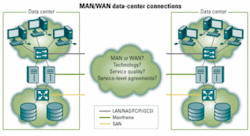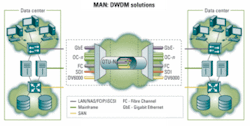Enterprise storage needs influence metro networks
One type of MAN service garnering attention in recent years has been the broad category of “storage networking.” To the enterprise, that would refer to the need for back office network infrastructure tasked with handling the mission-critical data needed to run the business. One of the enterprise’s network requirements is bandwidth dedicated to disaster recovery (DR) and business continuance (BC). There are a number of options to consider here, ranging from mainframe-specific channel extension for remote tape and disk storage devices over leased lines to SANs based on custom-built DWDM networks.
Carriers providing MAN/WAN services must continue to pay attention to BC/DR service requirements because:
• BC/DR supports a critical part of the enterprise infrastructure.
• Enterprises spend a significant amount of money on these resources.
• MAN/WAN costs for enterprises dominate overall solution economics, so competitiveness is key.
Enterprise BC/DR requirements have always influenced the architecture of the metro, and increased focus on higher performance as well as support of greater distances for these applications will strengthen this trend (see Figure 1). Given these heightened enterprise requirements and influences on the MAN/WAN, there is an enhanced opportunity to leverage today's existing SONET/SDH infrastructure and emerging Ethernet-based architectures to deliver unified voice, BC/DR, and LAN services.
Enterprise BC/DR can be divided into three fundamental groups in terms of the MAN/WAN: local only, leased-line approaches, and private networks (large financial operations, using dark fiber networks for 20-30-mi dual-site redundancy).For many enterprises, tape and truck is a sufficient solution to the problem of managing their data and insuring against loss of operations. For companies that require additional security, leasing lines from service providers (SPs) can provide the raw connectivity to support remote networked approaches, but they typically must employ highly evolved storage extension technologies (referred to as channel extension) to make environments designed for local connectivity work for distance applications.
The “power users” of BC/DR are the Global 500 businesses that use dark fiber-based private networks (e.g., using DWDM technology) to create high-performance networks and avoid leased-line charges. (Note: DWDM has been in use by large enterprise for BC/DR in mainframe environments since the mid-1990s.)The cost of downtime to the enterprise is the fundamental driver for BC/DR. In addition, compliance to recent legislation in the United States provides further motivation. The appropriate answer for any specific enterprise involves balancing the costs of a remote BC/DR option against the cost of downtime. Typically, the bandwidth charges to support a network-based approach can dominate the equation.
The likely decisions for an enterprise’s BC/DR team could be simply stated as follows: No MAN/WAN network needed, lease as few low-bandwidth channels as possible (to minimize costs); or, if the need for “business continuity insurance” is critical enough, make the investment in a simple point-to-point 30-mi infrastructure based on dark fiber.For SPs, the implications on MAN/WAN network architecture that follow from that are straightforward. BC/DR offerings can be considered as simple leased services for which SPs must compete based on price, quality, and type of service as well as service-level agreements (SLAs). Large-scale BC/DR will be supported via a DWDM network and likely be handled by via leased fiber or a custom private build by a service provider-and therefore is not part of the general MAN/WAN services infrastructure.
From a historical perspective then, MAN/WAN SPs simply saw an enterprise demand for leased channels, with no indication of the underlying traffic sources or the drivers behind it.
DWDM technologies have been deployed for years in the WAN on fiber-exhausted long-haul routes. The concept, however, of using DWDM in the MAN as a ring architecture to reduce cost and replace SONET in the interoffice facility emerged in the late ’90s. Coincidentally, one of the interesting results of this architectural change was the similarity between a carrier-focused DWDM system and an enterprise private-network DWDM offering for BC/DR.
Service and equipment providers became aware that the same technology targeted at the next generation ring could be used to go after the “hidden” opportunity to sell high-end storage connectivity services. This opportunity emerged concurrently with one of the larger enterprise spending influences ever: Y2K. Today, DWDM continues to be used by enterprises and MAN SPs as the private-network infrastructure of choice for BC/DR applications.
Next generation DWDM technologies have closed the technology gap between enterprise and carrier requirements, and the cost points of the technology have dropped to where “wavelength services” are widely available in most large metro areas. SPs are able to offer individual wavelength services or deploy DWDM as a private dedicated network to suit enterprise needs (see Figure 2).
Metro services therefore are readily addressed by DWDM technology, but longer-distance WAN offerings for BC/DR are poised to undergo a dramatic change. The demand for these high-end services is increasing dramatically-and at the same time, the technology of choice to deliver these services is evolving.
To date, enterprise demand for long-distance WAN bandwidth for BC/DR has been fulfilled via low-bandwidth leased telecom services: T1, NxT1, T3, and more recently OC-3c. SPs offer a telecom service to the enterprise, and the enterprise in turn uses specialized equipment to adapt their storage data flows into this telecom “pipe.” Changes in the enterprise requirements for BC/DR applications promise again to greatly affect SPs, likely causing them to reconsider the optimal approach to architecting the WAN.
Recent events have brought about significant changes in enterprises’ perspectives on their BC/DR requirements. As a result, the appeal to the enterprise for short (<50-km) metro wavelengths is being augmented by a renewed requirement for longer-distance services. Typically, storage applications used for BC/DR require that the WAN services underlying the data transport must have the following characteristics:
• Provide dependable, secure, clear channels.
• High performance and reliability.
• High-bandwidth capabilities.
• Effectively transport storage protocols like Fibre Channel, Ficon, Escon, and Gigabit Ethernet.
Traditionally, telecom services like T3 tended to meet these criteria. As a result, the traditional solution for data-center planners has been to lease these types of services. As bandwidth demands increase, migration from legacy PDH telecom service to SONET/SDH-based services will occur.
However, enterprises are also demanding more data-centric services from their WAN providers. Ethernet services are emerging as the right technology for enterprises, and a wide variety of service qualities and performance are available to suit the end user’s applications.
For long-distance storage replication applications, SP Ethernet offerings are emerging as the next generation alternative to SONET/SDH services. Like SONET/SDH, these offerings have strong SLAs, are offered by many providers and competitive, offer a high level of management and service visibility, and support connectivity to virtually any enterprise location, MAN/WAN or international, as required.
What are the implications of that on the MAN architecture? Changes in BC/DR requirements force an increase in enterprise bandwidth requirements toward long-distance SONET/SDH and Ethernet services optimized for storage and managed/deployed by SPs (see Figure 3). The benefit is clear to both parties: The enterprise gets an optimized high-value service and SPs are able to use either their existing SONET/SDH infrastructure to deliver this service or offer the service on their next generation data-based network.
MAN SPs will continue to offer voice/TDM services to the enterprise, and that will be the mainstay of their revenue base. The evolution in BC/DR for the enterprise means storage connectivity services can and will be efficiently and cost-effectively deployed alongside existing services. This commonality between traditional services and storage services means networks can be easily unified on a single platform, delivering a services bundle to the enterprise to provide additional value and boost provider revenues.
Service and equipment providers are making a tremendous effort to provide IP and Ethernet services efficiently alongside traditional services. Some of the more effective strides in recent years have been in the development of Ethernet on SONET/SDH technology. Rather than taking the view that IP as an infrastructure will replace SONET/SDH, a more practical view might be to see both SONET/SDH and Ethernet as the unifying technology for voice, IP, and storage-the three fundamental service types for the enterprise.
Business continuance/disaster recovery represents a significant source of enterprise spending and has increased in priority. A new class of solutions is being developed that will require access to large amounts of MAN and WAN bandwidth at distances >120 km. Not only will this requirement drive demand for bandwidth, but also it is optimally served via carriers’ SONET/SDH and Ethernet networks. That frees the MAN/WAN architect from planning and designing services based on wavelength services alone and allows the standard chosen network infrastructure to be used as the underpinning for all three primary enterprise services: voice, IP, and storage.Paul Schoenau is senior product manager at Ciena (Linthicum, MD, www.ciena.com).



